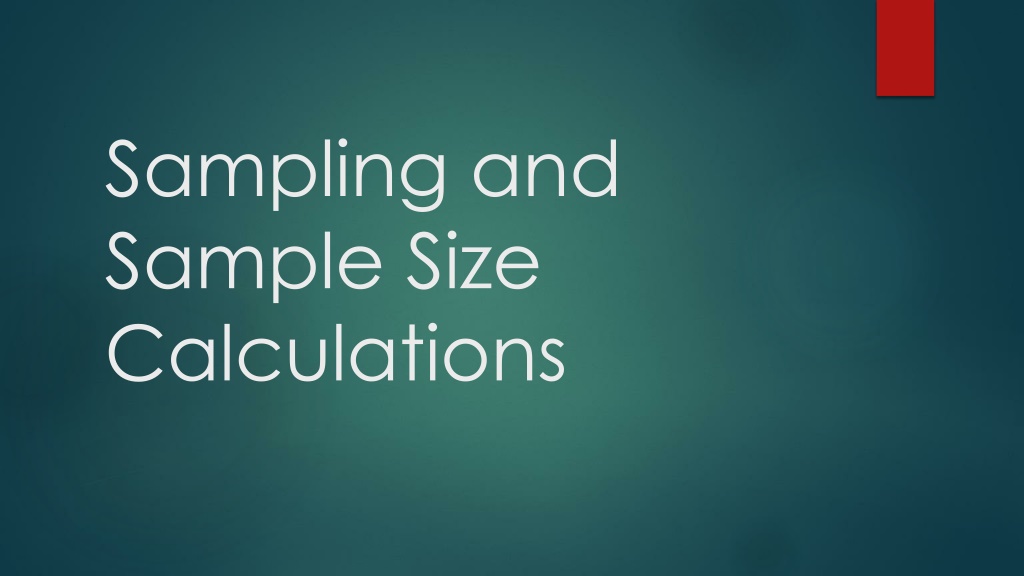Understanding Sampling Methods and Errors in Research
Sampling is crucial in research to draw conclusions about a population. Various methods like simple random sampling, stratified sampling, and systematic sampling help in selecting representative samples. Sampling error arises due to differences between sample and population values, while bias leads to systematic errors. It's essential to address bias and errors to ensure accurate research outcomes. Inferential statistics play a vital role in analyzing samples and deriving population inferences.
Uploaded on Jul 29, 2024 | 0 Views
Download Presentation

Please find below an Image/Link to download the presentation.
The content on the website is provided AS IS for your information and personal use only. It may not be sold, licensed, or shared on other websites without obtaining consent from the author. Download presentation by click this link. If you encounter any issues during the download, it is possible that the publisher has removed the file from their server.
E N D
Presentation Transcript
Sampling and Sample Size Calculations
Sampling Sampling is the process of selecting units from a population of interest. There are multiple methods that can be used to collect a sample. These sampling methods have specific names and can be classified as either probabilistic (which means some form of random sampling) or non-probabilistic (purposive sampling, as opposed to random sampling). Examples of common random sampling methods include: Simple Random Sampling (SRS) Stratified Random Sampling (StRS) Systematic Random Sampling (SyRS) Cluster Random Sampling (ClRS) Multistage Sampling
Sampling Error A measurement of a random sample has the best chance (probability) of approximating the expected value of the population. Sample measurements will reflect some random sampling error. Random sampling error simply refers to the fact that the sample measure is not the likely to be the same as the population, and thus, there is a certain amount of error associated with samples (difference between the sample measurement and the actual population value). Random sampling error is expected and O.K. Statistical procedures, including sample size estimation, take sampling error into account. Bias, or sampling bias, is NOT O.K. and can lead the researcher to draw inaccurate conclusions about the population.
Sampling or Measurement Bias Systematic error in an estimate. Bias can be the result of any factor that leads to an incorrect estimate, one that systematically over or under estimates the parameter value of the population. Sampling Bias needs to be thought about and investigated prior to data collection. To illustrate bias vs non-bias, imagine multiple random samples (could be across multiple studies), because the sampling method is random, we would expect that if multiple samples were selected, the average of the sample averages on a given measure would be the expected value of the population parameter. Although there is sampling error within a given single sample, if multiple random samples were to be selected, then an unbiased measurement would be one where the average of the samples average measurement is representative of the population value. This would not be the case for a biased measure. If sampling or measurement bias exist, then that means that the average of the measure from multiple random samples is NOT representative of the population parameter. We can use statistics and rules of probability to address sampling error . Which is something we do when calculating the sample size for a study.
Process When considering a potential quantitative research project, the researcher will identify the population they are interested in studying, then determine a sampling method to allow for the collection of a sample from the population, and then analyze the sample data with the goal of generalizing the findings back to the population from which the sample was drawn. Statistical procedures designed to be used to analyze a sample and generalize the findings back to the population are called Inferential Statistics.
Sample Size Estimation (slide 1 of 3) There are two primary approaches to sample size calculations, the precision- based approach, as opposed to the power-based approach. The use of the precision-based approach is used when the researcher is interested in estimating the proportion of the population, or the mean value of the population on some construct, to a specified level of precision (i.e., the bound ) and certainty. For purposes of this course, the focus will be primarily on the precision- based approach. The other approach, which is not addressed in-depth within this course, is the power-based approach. One would use the power-based approach to estimate the sample size needed for testing a hypothesis that is comparing groups. For the power-based approach, the researcher needs to decide on how small of a difference they would like to be able to detect, and with what degree of certainty.
Sample Size Estimation (slide 2 of 3) It is recommend that after calculating a preliminary estimate of the sample size needed, the researcher then consult with a statistician to ensure all considerations have been taken into account.
Sample Size Estimation (slide 3 of 3) Review sample size estimation materials provided within the Module. Sampling Terms Confidence Interval (precision) Confidence Level (certainty) Sample Size Sample Size Calculations for SRS (formulas) For PROPORTION estimation For Mean estimation Sample size Calculator (excel file set up to do the calculations based on various inputs) Will work through sample problems from bottom of Sample Size Calculations document.
See Sample Size Calculations (pdf) document located within the Module. Variables needed for: Sample Size Calculation for Proportion Estimation
See Sample Size Calculations (pdf) document located within the Module. Variables needed for: Sample Size Calculation for Mean Estimation
Next steps Review the provided resources within the module related to sampling and sample size calculation Review the provided video clip within the module showing the use of the Sample Size Calculator Open the Sample Size Calculator Excel spreadsheet from the module and work through the sample problems.






























